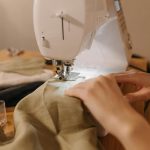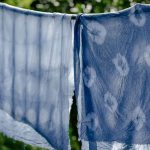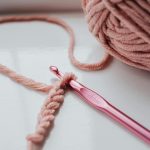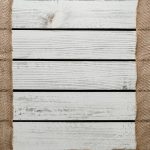When you're choosing cambric for your project, it's crucial to consider factors like weight, type, and intended use. Lightweight cambric might work wonders for certain garments, while heavier options can provide the structure you need for bags or dresses. You'll also want to think about fabric composition—cotton offers breathability, while synthetics can add durability. But that's just the tip of the iceberg; understanding how to match cambric with your specific design vision can make all the difference in the final outcome. So, what should you prioritize next?
Table of Contents
Understanding Cambric Fabric
Cambric fabric, known for its lightweight and crisp texture, is a versatile choice that can elevate your sewing projects. This finely woven cotton fabric typically features a smooth surface, which makes it perfect for a range of applications, from clothing to home décor.
When you're selecting cambric, you'll appreciate its breathability and softness, making it an excellent option for warm-weather garments. You'll find that cambric comes in various weights, allowing you to choose the right thickness for your specific project.
Whether you're creating delicate blouses or sturdy linings, understanding the fabric's properties can help you achieve the desired results. It's also worth noting that cambric is easy to work with; its stable nature means it holds up well during cutting and sewing, minimizing the risk of fraying.
Additionally, cambric fabric often comes in a variety of colors and patterns, giving you the creative freedom to match your vision. When you know what cambric is capable of, you can confidently incorporate it into your designs and enjoy the process of bringing your ideas to life.
Types of Cambric
When choosing cambric, you'll want to consider the different types available, including cotton and synthetic options.
You'll also find varying weights and thicknesses, which can impact your project's final look and feel.
Plus, the color and pattern choices can really make your fabric stand out, giving you plenty of ways to express your style.
Cotton Vs. Synthetic Cambric
Choosing between cotton and synthetic cambric can significantly impact your sewing projects, as each type offers distinct advantages and characteristics.
Cotton cambric is known for its natural fibers, providing breathability and softness. If you're working on projects like baby clothes or summer garments, cotton's comfort and absorbency can be a big plus. Plus, it's typically more eco-friendly, which may align with your values.
On the other hand, synthetic cambric, made from materials like polyester, brings its own set of benefits. It's often more durable and resistant to wrinkles, shrinking, and fading, making it ideal for items that require a bit more resilience, such as curtains or bags. If you're looking for a low-maintenance fabric that holds its shape, synthetic cambric might be the way to go.
Ultimately, choosing between cotton and synthetic cambric boils down to your project's requirements. Think about the feel, durability, and the care you're willing to invest in your fabric. By weighing these factors, you'll be better equipped to select the right type of cambric that fits your sewing needs.
Weight and Thickness Options
Understanding the weight and thickness options available in cambric can help you select the perfect fabric for your specific sewing project.
Cambric typically comes in a range of weights, from lightweight to medium and heavy options. Lightweight cambric is ideal for delicate garments like blouses or linings, while medium-weight cambric works well for versatile projects such as dresses and shirts. Heavy cambric is perfect for structured items like jackets or bags, giving them the necessary durability.
When considering thickness, think about how it will affect your project's drape and overall appearance. Thicker cambric tends to hold its shape better, making it suitable for tailored pieces. On the other hand, thinner cambric drapes beautifully, creating softer silhouettes.
It's also essential to consider the intended use of your finished item. For instance, if you're making a child's garment, a medium-weight cambric can provide comfort and durability. If you're working on a craft project, lighter options might be more appropriate.
Ultimately, by understanding these weight and thickness options, you'll be well-equipped to choose the right cambric for your needs.
Color and Pattern Choices
The variety of colors and patterns available in cambric allows you to express your creativity and find the perfect match for your sewing project. Whether you prefer bold, vibrant hues or soft, pastel shades, there's a cambric option that fits your vision. Solid colors offer versatility, allowing you to pair them with a range of fabrics, while patterned cambric can add an eye-catching element to your work.
When considering patterns, think about the overall style of your project. Floral designs work beautifully for dresses and home decor, while geometric patterns can give a modern twist to shirts or accessories. Stripes and polka dots can be playful, perfect for children's clothing or quirky items.
Don't hesitate to mix and match colors and patterns for a unique look. Layering different prints can create visual interest, but it's essential to maintain balance. Stick to a color palette that complements your chosen patterns to keep everything cohesive.
Ultimately, the right color and pattern choices will elevate your project, making it truly one-of-a-kind. So, take your time exploring the options; your creativity deserves it!
Weight and Thickness Considerations
When selecting cambric, you should pay close attention to its weight and thickness, as these factors significantly impact its suitability for your project.
Generally, cambric comes in various weights, typically ranging from lightweight to medium weight. Lighter cambric is perfect for delicate projects, such as linings or lightweight garments, where drape and flow are essential.
On the other hand, if you're tackling a project that requires more structure or durability, you'll want to opt for medium-weight cambric. This thickness provides added strength and can withstand wear and tear better than its lighter counterparts.
Additionally, consider how the weight and thickness will affect your sewing process. Thicker fabrics may require a more robust needle and can be trickier to sew, while lighter options can be easier to manipulate but may need more care to prevent fraying.
Ultimately, your choice should align with the functionality and aesthetic you want to achieve. By carefully evaluating the weight and thickness of your cambric, you'll ensure that your project not only looks great but also stands the test of time.
Common Uses of Cambric
What makes cambric a popular choice for various sewing projects is its versatility and lightness, which lend themselves well to a range of applications. You'll find that cambric works wonderfully for both clothing and home decor items. Whether you're creating a delicate blouse, a cozy children's garment, or stylish curtains, cambric delivers the durability and comfort you need.
Here's a quick overview of common uses for cambric:
| Use | Description | Benefits |
|---|---|---|
| Clothing | Dresses, blouses, and shirts | Breathable and light |
| Home Decor | Curtains, tablecloths, and napkins | Elegant finish |
| Crafts | Quilting, embroidery, and appliqué | Easy to work with |
| Accessories | Scarves, bags, and headbands | Stylish and functional |
| Linings | Garment linings | Adds structure |
With its appealing characteristics, cambric is an excellent choice for a variety of projects. No matter what you decide to make, you can count on cambric to enhance your creations.
Matching Cambric With Projects
Choosing the right cambric for your project can enhance its overall look and functionality, ensuring that you achieve the desired outcome in your sewing endeavors.
To match cambric with your project, start by considering the purpose of your creation. For lightweight garments or delicate linings, opt for a finer cambric that drapes beautifully. If you're making something sturdier, like a bag or home decor, a heavier-weight cambric will provide more durability.
Next, think about the project's style. If you're aiming for a casual, relaxed vibe, choose cambric with fun patterns or colors. For more formal items, select solid colors or subtle prints that convey sophistication. Pay attention to the texture as well; a smooth finish might work better for formal wear, while a slightly textured fabric adds interest to casual pieces.
Lastly, don't forget about the color palette. Consider the overall color scheme of your project and choose cambric that complements or contrasts effectively.
Care and Maintenance Tips
Taking care of your cambric is essential for its longevity and appearance.
You'll want to follow proper washing and drying techniques to keep it looking fresh, and store it correctly to prevent damage.
Let's explore some practical tips to ensure your cambric stays in great shape.
Washing and Drying Techniques
To keep your cambric looking its best, always wash it in cold water and air dry whenever possible. Hot water can cause shrinkage and fading, so stick to the gentle cycle on your washing machine. If you're hand washing, use a mild detergent, and be sure to rinse thoroughly to remove all soap residues. Avoid bleach, as it can weaken the fibers and alter the color.
When it comes to drying, hang your cambric on a clothesline or lay it flat on a clean surface. Direct sunlight can cause colors to fade, so try to find a shaded area for drying. If you must use a dryer, opt for the lowest heat setting and remove the fabric while it's still slightly damp to prevent over-drying.
After drying, give your cambric a light press with a cool iron if needed. Always check the care label for specific instructions, as some cambric blends may have unique requirements.
Following these washing and drying techniques will help maintain the quality and appearance of your cambric, ensuring it stays beautiful for all your projects.
Storing for Longevity
Properly storing your cambric is essential if you want to preserve its quality and prevent damage over time. Follow these care and maintenance tips to ensure your fabric remains in excellent condition for future use.
- Keep it Dry: Store your cambric in a cool, dry place. Moisture can lead to mold and mildew, which can ruin your fabric. Consider using silica gel packets in your storage container to absorb excess humidity.
- Avoid Direct Sunlight: UV rays can fade colors and weaken fibers. Use opaque storage bins or cover your cambric with a light-blocking fabric to protect it from sunlight.
- Use Acid-Free Materials: When folding or storing, use acid-free tissue paper to separate layers. This prevents creases and protects the fabric from degradation caused by acidic materials.
Where to Buy Cambric
You can find cambric at local fabric stores, online retailers, or specialty shops that focus on textiles.
Local fabric stores are a great starting point. They often carry a variety of cambric weights and colors, allowing you to feel the fabric before buying. Plus, staff can offer advice on the best options for your specific project.
If you prefer shopping from home, online retailers provide an extensive selection. Websites like Amazon, Etsy, or fabric-specific sites allow you to compare prices and read customer reviews. Just make sure to check the return policy, as you want to ensure you're satisfied with your purchase.
Specialty textile shops may also offer unique cambric options, including organic or hand-dyed fabrics. These shops can be a bit pricier, but the quality and uniqueness might be worth it depending on your project.
Before making a decision, consider your budget, project requirements, and the specific characteristics of the cambric you need.
Whether you choose local or online shopping, you'll find the perfect cambric to enhance your next creative endeavor.
Frequently Asked Questions
Can Cambric Be Used for Outdoor Projects?
Yes, cambric can be used for outdoor projects, but it's important to consider its durability and weather resistance. You'll want to ensure it's treated or protected if exposed to moisture or harsh conditions.
Is Cambric Fabric Eco-Friendly?
Yes, cambric fabric can be eco-friendly, especially if it's made from organic cotton or recycled materials. When choosing cambric, look for certifications like GOTS to ensure it meets sustainable standards.
How Does Cambric Compare to Other Fabrics?
Cambric's lightweight, breathable nature sets it apart from heavier fabrics. It's smoother than cotton and more durable than many synthetics, making it a great choice for projects that need both comfort and strength in fabric.
Are There Any Allergies Related to Cambric?
Yes, some people can be allergic to cambric, especially if it's blended with synthetic fibers or treated with chemicals. If you have sensitive skin, it's best to test a small area before using it extensively.
Can I Dye Cambric Fabric Easily?
Yes, you can dye cambric fabric easily. Just make sure to use the right dye for the fabric type, and follow the instructions carefully. It'll give you vibrant colors that enhance your project beautifully.
- Does Chiffon Fabric Stink - July 15, 2025
- Does Chiffon Fabric Affect the Economy - July 15, 2025
- Does Cotton Fabric Have a Nap - July 15, 2025







